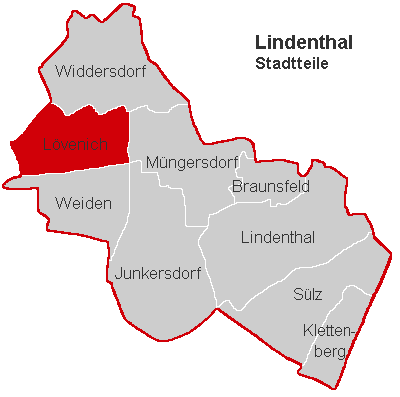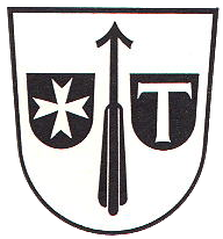
Lövenich, Cologne: Visiting Hours, Tickets, and Historical Sites Guide
Date: 14/06/2025
Introduction to Lövenich: History and Cultural Significance
Nestled in Cologne’s western Lindenthal borough, Lövenich is a district where layers of history coalesce with vibrant suburban life. From its early days as a Roman-era settlement—evidenced by archaeological finds near the Römergrab Köln-Weiden—to its medieval transformation under the Archbishopric of Cologne, Lövenich presents a historical tapestry for the curious traveler. Incorporated into Cologne in 1975, Lövenich has balanced preservation of its unique heritage with urban growth, making it a rewarding destination for history enthusiasts, nature lovers, and cultural explorers alike. With easy access via the Köln-Lövenich station, the district offers tranquil green spaces, medieval churches, and a welcoming village core. This guide details Lövenich’s historical sites, practical visitor information, travel tips, and nearby attractions, ensuring a memorable journey into one of Cologne’s hidden gems (Touropia, Mapcarta, Britannica, Cologne Tourism).
Table of Contents
- Early Origins and Roman Influence
- Medieval Development and Ecclesiastical Ties
- Integration into Greater Cologne
- Key Historical Sites and Visitor Information
- Historical Events and Local Significance
- Lövenich’s Role in the Cologne Region
- Notable Surrounding Areas
- Visitor Tips
- Frequently Asked Questions (FAQ)
- Visuals and Interactive Elements
- Related Articles
- Plan Your Visit
- Lövenich: Overview, Attractions, and Visitor Tips
- Historical Landmarks and Heritage
- Transportation and Accessibility
- Culinary, Shopping, and Events
- Nearby Points of Interest
- Cologne Cathedral: Visiting Hours and Practical Guide
- Summary and Recommendations
- References
Early Origins and Roman Influence
Lövenich’s roots can be traced to antiquity, when the region was a rural outpost supporting the Roman city of Colonia Claudia Ara Agrippinensium (today’s Cologne). Archaeological evidence—including remnants of Roman roads and the notable Römergrab Köln-Weiden—attest to its role in Roman times (Touropia). The Römergrab, a remarkably preserved 2nd-century tomb, offers visitors a direct connection to this ancient past (Mapcarta).
Medieval Development and Ecclesiastical Ties
During the Middle Ages, Lövenich evolved into a structured village, heavily influenced by the powerful Archbishopric of Cologne. Its fertile land supported agriculture, while its integration into the ecclesiastical sphere is reflected in local landmarks like St. Severin Church, a focal point of spiritual and communal life (Britannica, Mapcarta).
Integration into Greater Cologne
In the 19th and 20th centuries, Cologne expanded, gradually absorbing surrounding villages. Lövenich was officially incorporated into the city in 1975, bringing modern infrastructure and improved transport links—including the vital Köln-Lövenich station—while preserving its distinct local identity (Britannica).
Key Historical Sites and Visitor Information
St. Severin Church
A testament to Lövenich’s medieval heritage, St. Severin Church retains historic elements and remains central to local community life (Mapcarta).
- Visiting Hours: Monday–Saturday, 9:00–18:00; Sunday, 10:00–17:00. Check for special services.
- Tickets: Free entry (donations welcome).
- Accessibility: Wheelchair access available.
- Guided Tours: Weekends/by appointment via local parish.
Römergrab Köln-Weiden
This Roman tomb, east of Lövenich, provides insight into funerary practices and society in Roman Cologne (Mapcarta).
- Visiting Hours: April–October, 9:00–19:00; limited winter hours—confirm before visiting.
- Tickets: Free.
- Accessibility: Outdoor site; uneven surfaces.
- Guided Tours: Seasonally available via local tourism offices.
Köln-Lövenich Station
Opened in 1840, this railway station was key to Lövenich’s transition from rural village to connected suburb (en.wikipedia.org).
- Travel Tips: Regular trains to Cologne’s center and beyond. Tickets available on-site and online.
Historical Events and Local Significance
Agricultural Heritage
Lövenich’s rural legacy endures in traditional farmhouses and historic field systems, reflecting centuries of agricultural activity.
Impact of World War II
During WWII, Lövenich escaped the worst destruction, preserving more of its historical core than central Cologne (Touropia). Postwar, it grew as a residential area for those relocating from the city.
Urban Expansion and Modernization
Rapid urbanization after WWII introduced new housing, schools, and commercial spaces, striking a balance between development and heritage preservation (Britannica).
Lövenich’s Role in the Cologne Region
Lövenich is a microcosm of Cologne’s history, where Roman origins, medieval traditions, and modern suburban life converge. Its proximity to the scenic Ville hills and connections to neighboring districts amplify its appeal as a gateway to both Cologne’s past and present (Cologne Tourism).
Notable Surrounding Areas
Adjacent districts include Weiden, Brauweiler, and Hücheln. Brauweiler Abbey, founded in the 11th century, is a notable nearby site worth visiting (Mapcarta).
Visitor Tips
- Begin at St. Severin Church: Explore the church’s medieval features and join a guided tour if possible.
- Römergrab Köln-Weiden: Experience Roman history with self-guided or scheduled tours.
- Arrive via Köln-Lövenich Station: Use public transport for easy access and explore the district on foot.
- Stroll the Old Village Core: Enjoy preserved architecture and remnants of Lövenich’s rural past.
- Extend Your Visit: Combine with Brauweiler Abbey and other sites in the Cologne Lowland (Mapcarta).
Frequently Asked Questions (FAQ)
What are the visiting hours for Lövenich’s main sites?
St. Severin Church: Generally 9:00–18:00 (Mon–Sat), 10:00–17:00 (Sun). Römergrab Köln-Weiden: 9:00–19:00 (Apr–Oct); check for changes.
Are tickets required?
Most sites are free; donations encouraged.
How do I get to Lövenich?
Take S-Bahn S12, S13, or S19 from Cologne Hauptbahnhof to Köln-Lövenich station (approx. 15 min).
Are guided tours available?
Yes, for key sites; check with local tourism offices.
Is Lövenich accessible for visitors with disabilities?
St. Severin is wheelchair accessible; Römergrab has uneven terrain.
Visuals and Interactive Elements
- Include images of St. Severin Church, Römergrab Köln-Weiden, and old Lövenich village with descriptive alt text.
- Embed an interactive map showing Lövenich’s location and key sites.
- Offer virtual tours where available via local tourism websites.
Related Articles
Plan Your Visit
Download the Audiala app for guided audio tours, up-to-date visitor information, and exclusive content. Follow us on social media for the latest news on Cologne’s hidden gems.
Lövenich Overview: Attractions and Visitor Tips
Lövenich combines historic charm with modern amenities. It is easily accessible by S-Bahn (S12, S13, S19) and bus, and is close to major motorways A1 and A4, making it convenient for all travelers.
Main attractions include:
- St. Michael’s Parish Church: A centerpiece of Lövenich’s old village, open during daylight hours.
- Old Village Center: Cobblestone streets and half-timbered houses reflecting its rural past.
- Stadtwald: Nearby city forest for hiking and relaxation.
- Local Cafés, Shops, and Community Events: Experience authentic suburban Cologne.
Tips:
- Visit in spring through autumn for the best weather.
- Enjoy photography in the old village and at St. Michael’s Church.
- Guesthouses and small hotels offer quiet stays.
Historical Landmarks and Heritage
Lövenich’s name derives from the Celtic Luviniacum, first mentioned in 1028 (de.wikipedia.org). The area was influenced by the Knights Hospitaller and the Archbishop of Cologne.
19th/20th-century suburban houses near the railway station highlight its evolution (de.wikipedia.org).
Transportation and Accessibility
- Köln-Lövenich Station: Opened in 1840, modernized for S-Bahn; connects to central Cologne (en.wikipedia.org).
- Green Paths: Trails along the Kölner Randkanal for walking and cycling (de.wikipedia.org).
- Accommodation: Options include Hotel Lövenich and Pension zur Post.
Culinary, Shopping, and Events
- Bakeries and Cafés: Enjoy fresh bread, pastries, and local fare.
- Access to Cologne Breweries: Easy S-Bahn ride to Cologne’s Old Town for Kölsch beer (cologne-tourism.com).
- Shops: A mix of small shops and supermarkets; quick access to Cologne’s shopping streets (planetware.com).
- Festivals: Experience neighborhood Karneval and Christmas markets with a local flair (cologne-tourism.com).
Nearby Points of Interest
- Cologne City Center: S-Bahn brings you to the Cathedral, Old Town, museums, and nightlife (thecrazytourist.com).
- Day Trips: Explore the Rhine/Moselle valleys, Eifel National Park, Bonn, and Düsseldorf (mygermanyvacation.com).
Cologne Cathedral: Visiting Hours and Practical Guide
Overview:
Cologne Cathedral (Kölner Dom) is a UNESCO World Heritage Site dating to 1248 and completed in 1880. It features twin spires, stained glass, and the Shrine of the Three Kings.
Visiting Hours:
- Monday–Saturday: 6:00–19:30
- Sunday/Public Holidays: 7:00–19:30
Specific areas (tower, treasury) may have separate hours.
Tickets:
- Main interior: Free
- Tower: €6 adult/€4 reduced
- Treasury: €5 adult/€3 reduced
Tickets via official site.
Getting There from Lövenich:
Take S12, S13, or S19 from Lövenich station to Hauptbahnhof; cathedral is adjacent.
Accessibility:
Cathedral and Lövenich station are wheelchair accessible.
Summary & Final Recommendations
Lövenich is a distinctive district reflecting Cologne’s evolution from Roman roots to modern suburbia. Visitors can explore medieval and Roman sites, stroll tranquil green spaces, and enjoy excellent public transport links. For deeper exploration, opt for guided tours and visit nearby highlights like Brauweiler Abbey and Cologne Cathedral. Download the Audiala app for interactive maps and audio guides, and check Cologne Tourism for the latest updates. Lövenich offers an authentic, accessible gateway to Cologne’s rich southwestern heritage (Touropia, Britannica, Cologne Tourism).
References
- Touropia, Tourist Attractions in Cologne
- Mapcarta, Lövenich and Surroundings
- Britannica, Cologne, Germany
- Cologne Tourism, Arts & Culture Sights
- de.wikipedia.org, Lövenich (Köln)
- en.wikipedia.org, Köln-Lövenich Station
- planetware.com, Tourist Attractions in Cologne
- destinationabroad.co.uk, Is Cologne Worth Visiting?
- mygermanyvacation.com, Cologne Travel Guide






































































